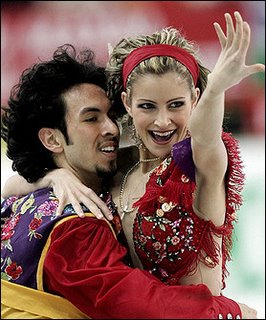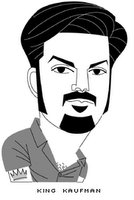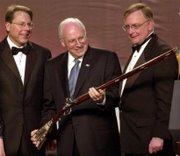
A few days ago the Men's competition was held, so now I've been able to see this new scoring system at work for them and the pairs. I must say my reaction is mixed. On the plus side, it's good to see them recognize that something was desperately wrong with the previous system, that the new way is more objective than the new way, and, probably most important, they've ditched that moronic system in which the final positions (i.e., who won which medals) were determined merely fromt he ordinal rankings of the two programs and replaced it with simply adding up the scores from the short program and the free skate. This aspect of the new system is both intuitively obvious (it's what they do in, as far as I know, every other event involving combining two scoring opportunities, like luge runs or ski jumps) and it is also less stupid.
Like, for example, after the men's short program, Yevgeni Plushenko's
score was head and shoulders above everybody else's, whereas positions 2 through about 8 were all within striking distance of each other. That's as it should be. Under the old system, Plushenko's 1st place would be treated as one step above American Johnny Weir's second place, who would be one step above Stephane Lambiel from Switzerland, etc., when in reality Weir's score of 80.00 was just about as close to American Matt Savoie's 69.15, ranked #8, as it was to Plushenko's 90.66. If one guy's first run is really that much better than a wide field behind him, then it is only right that it should be difficult to catch up with him but easy for the contenders in the closely-bunched field to rearrange their order.
So as far as that goes I'm all for the new system. My issue with the system is that it leans too heavy toward the technical side. The scoring is open-ended rather than being based on deductions from a perfect 6.0. That makes sense to me, but unfortunately what happens is that competitors simply pile on as many jumps as they can with the knowledge that each jump will add to their score. The result is that, for all the talk of the "program components" part of the score being the equivalent of the old "artistic impression" component and of equal value to the technical marks, the new system favors athletic jumpers with little aesthetic sense over those who can truly transform an athletic display into a thing of beauty.
Exhibit A is the runaway winner, Yevgeni Plushenko. There is no disputing that, from a technical standpoint, Plushenko was the best skater in the competition. But, as the commentators pointed out, he had no program. His idea of choreography was "watch me gear up for my next jump" and "if I wave my hands around meaninglessly it will add to my score."
Contrast that with the sublime Johnny Weir, whose "The Swan" short program took a real risk but turned it into one of the most elegant programs I've ever seen a man perform on ice --- and he mixed in quite a number of flawlessly-executed jumps while he was at it. Weir, whose very entertaining flamboyance has been
well-documented elsewhere, faltered a bit in the long program (AKA the free skate), but even there, his choreography and his ability to pull off that choreography with fluidity and authenticity. And yet for
both programs, Plushenko had the highest score amongst all the skaters for program components.
I really don't know the details of how the program components are calculated. For all I know, it's not the judges' faults, and their hands may have been forced by the system to give the highest p.c. scores to Plushenko. Or maybe it is the judges' faults, and they just gave him the top scores because, well, he's their golden boy and he's the best jumper. But either way, if the stated intention is for the program components to give some measure of the artistic impression of the performance, they've failed. Either by design or by implementation, the two components of the scores are very strongly correlated with each other, when they ought to be almost independent. Someone could, theoretically, skate beautifully but flub every jump.
I'm not asking them to turn figure skating into Ice Dancing. All of the elegant skaters I saw in competition were also accomplished, athletic jumpers and spinners. But there is a place in skating for both the technical and the aesthetic, and then needs to be reflected in the scoring. Otherwise all we have is a jumping contest, no more interesting to watch than freestyle aerial skiing.
Maybe Yevgeny Plushenko deserved his gold medal, and maybe not. As brilliant as his technical skills are, a skater with as dull a choreographer as his (and in a country with as proud a tradition of ballet as Russia, this should be cause for alarm) should not have run away with the competition the way he did. Is it just a coincidence that the underappreciated, more elegant style of skating is exemplified not only by the three American men but also by Michelle Kwan? The international sports world always seems to be looking for ways to screw over Americans, whether it's on the ice or the baseball diamond.

 Driving up Angeles Crest Highway, there started to be snow on the ground right around the point where Angeles Forest Highway starts. Shortly thereafter, traffic started to get congested as people were pulling over to the shoulder, what little of it there was, to let their families play in the snow. After the Mt. Wilson turnoff, traffic lightened up, and the farther I went into the mountains, the thinner the crowds got. Eventually I turned off and parked at the Three Points trailhead parking lot, a little way past Newcomb's Ranch.
Driving up Angeles Crest Highway, there started to be snow on the ground right around the point where Angeles Forest Highway starts. Shortly thereafter, traffic started to get congested as people were pulling over to the shoulder, what little of it there was, to let their families play in the snow. After the Mt. Wilson turnoff, traffic lightened up, and the farther I went into the mountains, the thinner the crowds got. Eventually I turned off and parked at the Three Points trailhead parking lot, a little way past Newcomb's Ranch.

















